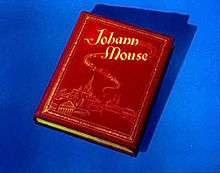Johann Mouse
| Johann Mouse | |
|---|---|
| Tom and Jerry series | |
 | |
| Directed by |
William Hanna Joseph Barbera |
| Produced by | Fred Quimby |
| Story by |
William Hanna Joseph Barbera |
| Narrated by | Hans Conried |
| Music by |
Johann Strauss Scott Bradley Jakob Gimpel |
| Animation by |
Kenneth Muse Ray Patterson Ed Barge Irven Spence |
| Backgrounds by | Robert Gentle |
| Distributed by | Metro-Goldwyn-Mayer |
| Release date(s) |
|
| Color process | Technicolor |
| Running time | 7:57 |
| Language | English |
| Preceded by | Jerry and Jumbo |
| Followed by | That's My Pup! |
Johann Mouse is the 75th one-reel animated Tom and Jerry short, created in 1952 directed by William Hanna and Joseph Barbera and produced by Fred Quimby with music by Scott Bradley and Jakob Gimpel (who plays the piano in this short) and narration by Hans Conried. The cartoon was animated by Kenneth Muse, Ray Patterson, Ed Barge and Irven Spence, with backgrounds by Robert Gentle. Placing the popular cat and mouse characters in Vienna, the capital of the Austro-Hungarian Empire, the cartoon is inspired by the work of Viennese composer Johann Strauss II, and was released on March 21, 1953, by Metro-Goldwyn-Mayer.
Johann Mouse was nominated for the Academy Award for Best Animated Short Film, marking the cat and mouse duo's tenth consecutive nomination and their twelfth nomination for the last thirteen years (Tom and Jerry was nominated for every year since 1940, except for 1942). It won the Oscar, becoming the duo's seventh win in the category, tying them with Walt Disney's Silly Symphonies for the record of the most awards in the Best Animated Short Film category. The duo would later be nominated for the thirteenth and final time in the category two years later, in 1954 for the short Touché, Pussy Cat!. The Oscar win this time, however, wasn't mentioned as such in the cartoon's opening titles, unlike the other six Oscar-winning cartoons. This is also the only Tom and Jerry short in the Golden Age of Animation to have a voice credit.
Plot
"This is the story of a waltzing mouse. His name was Johann and he lived in Vienna (Austria) in the home of Johann Strauss," narrates Hans Conried.
In the walls of the house of Johann Strauss lived Johann Mouse, portrayed by Jerry. Little Johann loved Strauss' music, and whenever the musician would play, the mouse would dance. And whenever the mouse would dance, Strauss' housecat, portrayed by Tom, would try to catch him but always fail.
One day, Strauss goes away on a journey, leaving Tom in a serious predicament (knowing that without music, Johann wouldn't dance). He picks up a manual on top of the piano: "How To Play The Waltz In Six Easy Lessons by Johann Strauss." Tom charges upstairs into the attic and teaches himself how to play, following the guidebook (which consists of how to correctly play the first eight/nine notes of The Blue Danube, in proper sequence), and after just six lessons, he is instantaneously an accomplished pianist.
Tom panics and takes to the piano downstairs and the mouse is mesmerised by the music, into dancing. Tom attempts to squash Johann with a poker, and as he stops playing to hit Johann, the mouse is roused from his spell and scrambles back towards the hole — until Tom resumes playing. Johann turns around, hypnotised once again. The heads of some servants wondering who was playing in their master's absence, pop through the door, observing the talented duo. As Tom grabs Johann, the servants applaud. Tom puts Johann down and returns to the piano, with Johann dancing again. The news quickly spreads around Vienna, reaching even the ears of the Emperor himself. Tom and Johann are summoned by a royal writ from the Imperial Palace to perform before the Court.
The next scene opens upon the throne hall, with the entire court in attendance (also heard in the beginning of the scene is "Kaiser-Walzer"). In the middle is a white grand piano. The doors open to reveal Tom and Jerry, both in tail-coats and bow-ties, who bow to the Emperor and enter the ballroom. Tom begins playing "Tritsch-Tratsch-Polka", and Jerry/Johann begins waltzing, occasionally using Tom's fingers as a dancing partner. After the narrator says "But, when the cat stopped playing..." Tom gives into his impulses and tries to capture Jerry, who again escapes into a hole in the wall. "It was the same old story", the narrator concludes. In the last scene, the mouse leaves his hole and dances, bowing to rapturous applause. Tom turns the page to reveals at the end of the cartoon (saying 'The End') and reads "An MGM Tom and Jerry Cartoon. Made in Hollywood, USA." as usual.
Availability
DVD
- Tom and Jerry's Greatest Chases, Vol. 1
- Tom and Jerry Spotlight Collection Vol. 1, Disc Two
- TCM Academy Award-Winning Classic Cartoons (Barnes & Noble Exclusive)
- Warner Bros. Home Entertainment Academy Awards Animation Collection: 15 Winners
- Warner Bros. Home Entertainment Academy Awards Animation Collection, Disc One
- Tom and Jerry: The Deluxe Anniversary Collection, Disc One
- Tom and Jerry Around the World
- Tom and Jerry: Musical Mayhem
- Tom and Jerry Golden Collection Vol. 2, Disc Two
External links
- Johann Mouse at The Big Cartoon DataBase
- Johann Mouse at the Internet Movie Database
- Johann Mouse at the Johann Strauss Society of New York